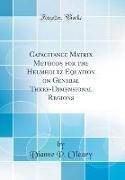Mehr lesen
Excerpt from Capacitance Matrix Methods for the Helmholtz Equation on General Three-Dimensional Regions
In the second section, we discuss the imbedding idea. Following a review of classical potential theory, we derive our capacitance matrix methods in Section 3. Section 4 focuses on algorithmic aspects which are of crucial importance in the develop ment of fast, reliable and modular computer code. We solve the capacitance matrix equations by conjugate gradient methods. These methods, originally used in a similar context by George are reviewed in that section. We also discuss how spectral information and approximate inverses of the capacitance matrices can be obtained and used at a moderate cost in computer time and storage. The fast Poisson solver which is used in our program is described in Section 5. It is numerically stable even for negative values of the coefficient c of the Helmholtz operator. Finally, we give details on the organization of our computer program and results from numerical experiments. These tests were designed to be quite severe and the method has proved efficient and reliable.
About the Publisher
Forgotten Books publishes hundreds of thousands of rare and classic books. Find more at www.forgottenbooks.com
This book is a reproduction of an important historical work. Forgotten Books uses state-of-the-art technology to digitally reconstruct the work, preserving the original format whilst repairing imperfections present in the aged copy. In rare cases, an imperfection in the original, such as a blemish or missing page, may be replicated in our edition. We do, however, repair the vast majority of imperfections successfully; any imperfections that remain are intentionally left to preserve the state of such historical works.

